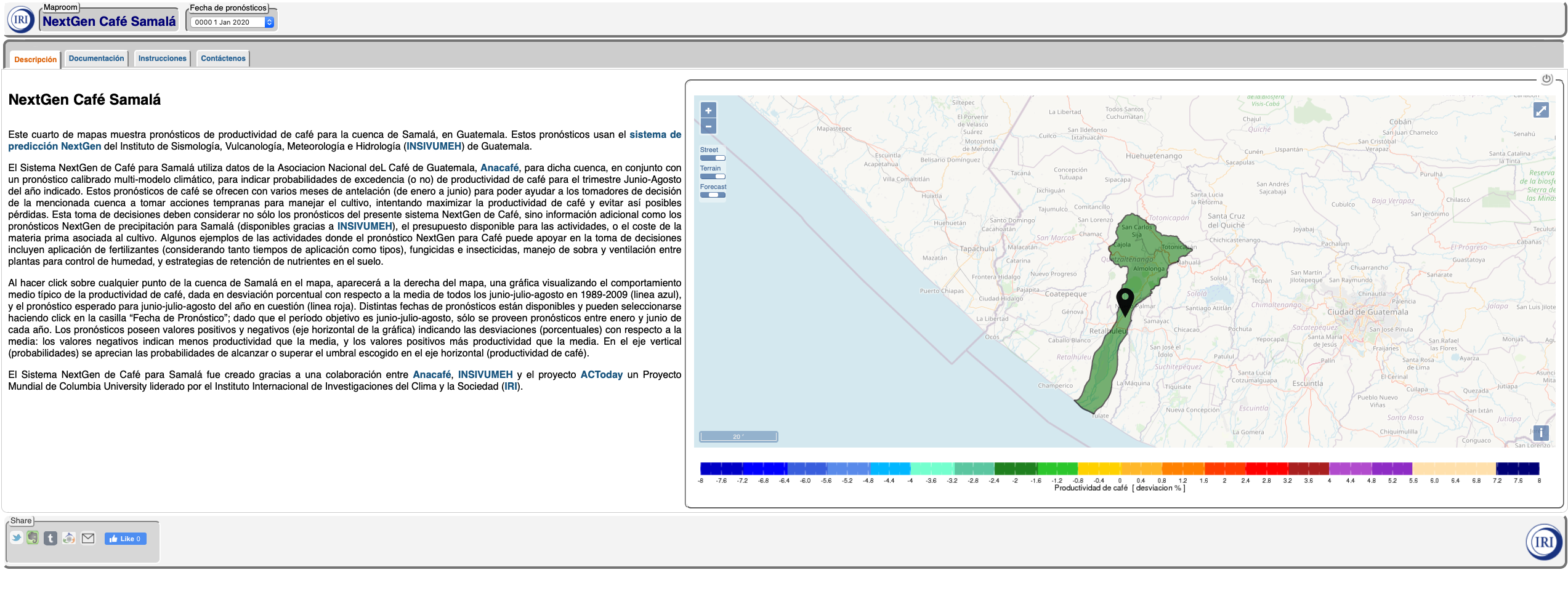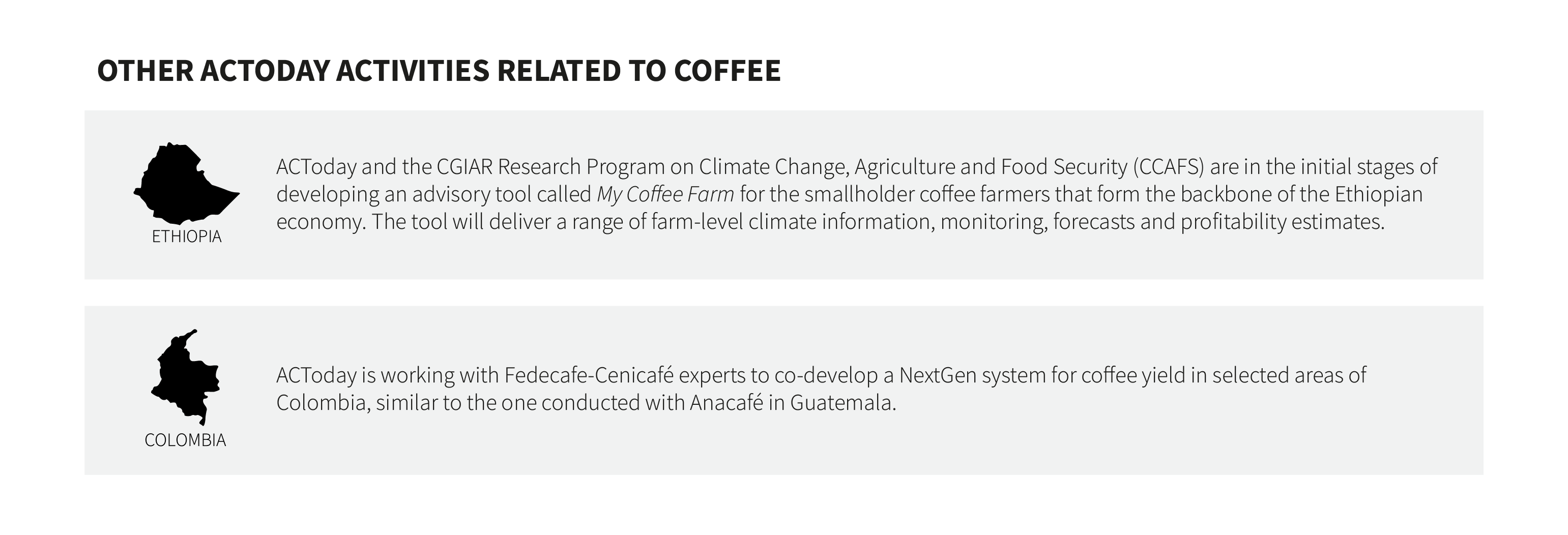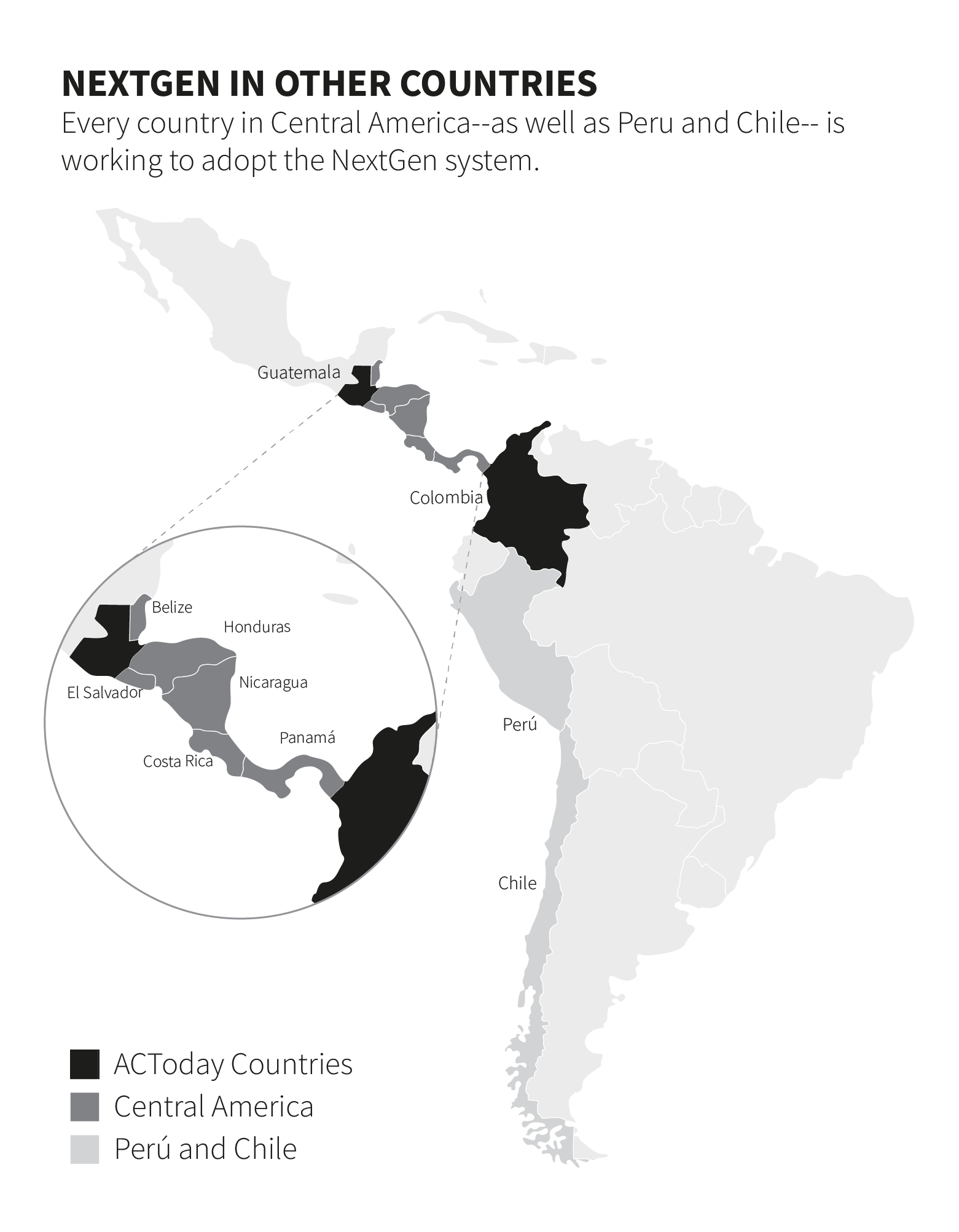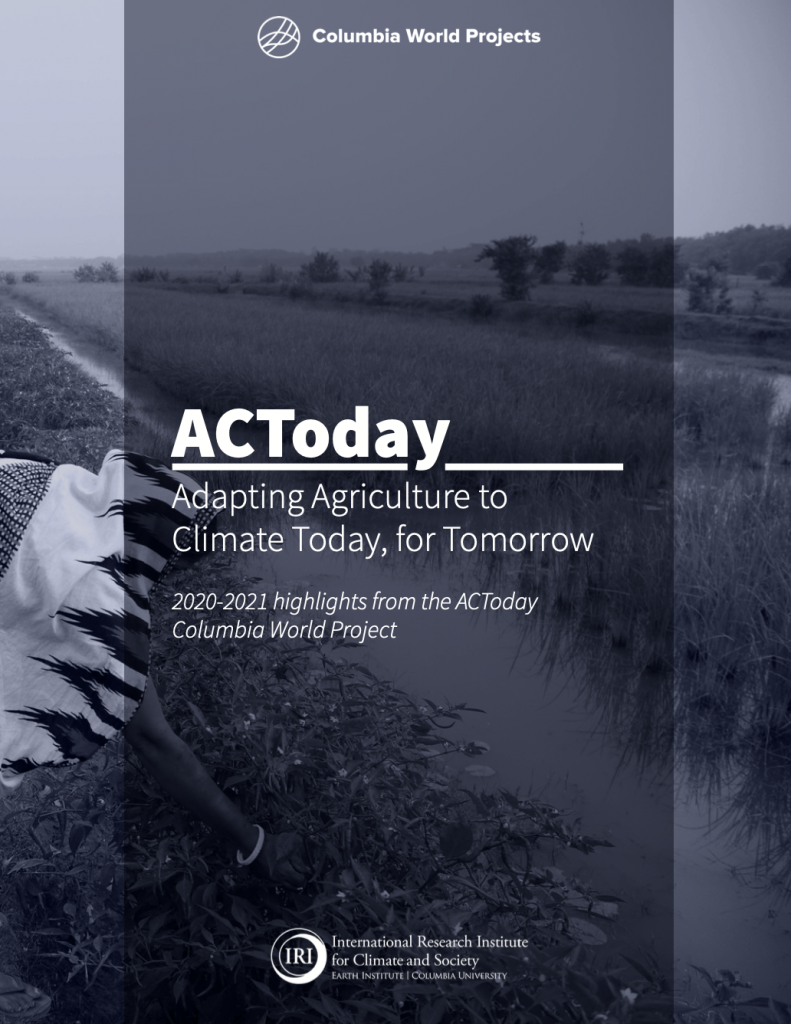
Introduction
We are excited to share our latest highlights from the Columbia World Project, ACToday. During a period marked by global upheaval and tragedy caused by the COVID-19 pandemic, we have been especially inspired to keep our work on track. We are proud of how quickly our country teams were able to adapt to the realities of the day and make outstanding progress.
ACToday remains focused on its goal of combating hunger by increasing climate knowledge in six countries that are particularly dependent on agriculture and vulnerable to the effects of climate change and fluctuations: Bangladesh, Colombia, Ethiopia, Guatemala, Senegal and Vietnam.
But the stories featured in this report underscore something larger: that the successes of our work are now leading to opportunities for us to go beyond the six project countries, and scale at regional levels and draw in new partners.
This is not an accident.
Through trainings and co-development of scientific and technical tools, our country teams have strengthened the capacities and capabilities of national meteorological services, enabling them to better meet the needs of the public and private sector institutions they serve. This in turn has bolstered their reputations and has led to increased demand for their services, not only in the food-security community but also in energy, public health and other sectors. In a similar fashion, ACToday teams are training staff within national ministries, agriculture extension services and research institutions to become more sophisticated users of climate information for decision making. These are foundational changes, ones that will continue to transform approaches to achieving food security in each country long after the ACToday project ends.
The climate services we’re building together bring decades of science and experience directly to bear on decisions the governments of each project country make when it comes to the wellbeing of their people.
University President Lee C. Bollinger launched Columbia World Projects in hopes of fulfilling a ‘Fourth Purpose’ of universities: supporting activities that focus the university’s research, expertise and resources to develop real and sustainable solutions for some of society’s most intractable problems.
A key word here is ‘sustainable’, which is why from the start, ACToday has focused on maintaining strong national and international partnerships based on trust and collaboration. The climate services we’re building together bring decades of science and experience directly to bear on decisions the governments of each project country make when it comes to the wellbeing of their people. Our efforts are leading to real change, and our successes have garnered the attention of neighboring countries and the international community.
As the COVID-19 pandemic reminds us: when good science is allowed to inform policy, all of society benefits.


Lisa Goddard and Walter Baethgen
International Research Institute for Climate and Society
Co-Leads of ACToday

Helping Provide Insurance to a Million Smallholder Farmers
(Scroll down for more)

Since its launch in 2017, ACToday has invested in forecasts, monitoring tools and other information products to help government agencies, humanitarian organizations and farmers better plan for droughts and other climate-related threats to food production.
These tools, which are an important component of climate services, are now directly enabling the World Food Programme (WFP), winner of the 2020 Nobel Peace Prize, to reach its target of providing a million smallholder farmers in Ethiopia with affordable index-based insurance against droughts and other climate risks.
Index insurance is an innovative, affordable type of insurance that’s tied to a measurement of weather, such as rainfall estimated by satellites or recorded at a local weather station. If the amount of rainfall during critical stages of a crop’s growth cycle doesn’t reach a pre-specified threshold, farmers who purchased the insurance automatically get compensated without having to file any claims. This innovation has significantly lowered the transaction costs and risks for insurance companies, enabling them to keep premiums low and helping millions of farmers access coverage previously unavailable to them.
During times of drought, insurance helps farmers and their families keep food on the table. In non-drought years, insurance coverage helps farmers feel safe to take out loans to buy fertilizer and other inputs that can significantly increase their yields and income. Research by the International Research Institute for Climate and Society (IRI) and other organizations have shown that insured farmers in Ethiopia accumulated almost double the level of savings that their non-insured counterparts did, and also invested more in seeds, fertilizer and assets such as oxen.

Both WFP and the World Bank are using ACToday tools to expand their index insurance programs in Senegal and Ethiopia (countries where ACToday is operating) as well as in Malawi, Zambia and Mozambique.
“ACToday helped us create the conditions for a major scale up in these countries by giving local insurance experts the capacity to design insurance products tailored to their area of coverage,” said Mathieu Dubreuil, Insurance Advisor at WFP. “This was an essential step that allowed us to expand into new regions and reach much bigger numbers of participants.”
The design tool Dubreuil refers to is a new ACToday maproom–a mapping platform powered by the IRI’s Data Library. It helps insurance experts visualize rainfall patterns over wide areas, allowing them to pool insurance contracts for multiple areas based on these patterns, as opposed to making different contracts for each area.
“Previously, we would decide where to expand insurance based just on where the poorest farmers were,” said ACToday insurance expert Rahel Diro. “But these aren’t necessarily the places where insurance would have the most benefit for the most people. The maproom allows us to pinpoint these areas.”
“ACToday helped us create the conditions for a major scale up in these countries by giving local insurance experts the capacity to design insurance products tailored to their area of coverage. This was an essential step that allowed us to expand into new regions and reach much bigger numbers of participants.”
Mathieu Dubreuil, Insurance Advisor at WFP
Such a platform–which delivers crop information, high-resolution climate forecasts, historical rainfall data and satellite observations, all in real time–wouldn’t have been possible without the infrastructure and services ACToday built and continues to support through its collaboration with national meteorological services.
Keeping the Focus on Farmers
How farmer-driven index insurance can help manage climate risks and make them more resilient and productive.
“We know from our decades of experience that index-insurance programs can’t scale up successfully if they don’t include farmers in the design process,” said Daniel Osgood, an economist at the International Research Institute for Climate and Society who is working on ACToday.
“Farmers are the only ones who truly understand their risks and opportunities, and whether or not the meteorological data on which the insurance index is based is accurately reflecting their crop losses,” he added. “They must have a solid understanding of which risks the insurance covers and doesn’t cover, or else they might make adaptation choices that would leave them unknowingly exposed.”
The process of working with farmers to develop responsible insurance products normally requires frequent community visits–a workable approach for projects covering a few dozen to a few hundred villages, but one that is too effort-intensive for projects that want to reach thousands or hundreds of thousands of farmers.
“We’re reducing the need for the insurance teams to visit every community, while still being able to crowdsource indispensable data from thousands of farmers.”
Daniel Osgood, IRI
Working with WFP and the World Bank in Senegal, ACToday has piloted new tools that allow farmers to use phone technology to participate in the design and verification of the index insurance being considered for their village. Farmers can share information via text messages, online forms, phone apps or by automated phone surveys asked in local languages. These tools are also, as part of ACToday, being tested across the Atlantic, in Colombia, where rice farmers in the Meta region are sending feedback to insurance providers working with Fedearroz, the country’s federation of rice producers.
“We’re reducing the need for the insurance teams to visit every community, while still being able to crowdsource indispensable data from thousands of farmers,” Osgood said. “This is also enabling insurance programs to continue despite the travel restrictions and other challenges brought on by the COVID-19 pandemic.”

Banner image credit: Georgina Smith/CIAT
ACToday operates in four of the top ten coffee-producing countries in the world: Colombia, Ethiopia, Guatemala and Vietnam. Minimizing climate risks to coffee production is a strategic component of ACToday’s goal of improving food security for hundreds of thousands of farmers who depend on the crop for income. A closer look at our work in Vietnam and Guatemala shows how ACToday is supporting this important sector.

Coffee is a big business in Vietnam, the world’s second largest producer, which exported more than $2.4 billion worth of the crop in 2019. Although coffee is not a food crop, its production plays a significant role in the food security of many communities who depend on the crop as a primary source of income.
Climate variability and change pose a growing threat, as rising temperatures and extreme weather subject farmers to increasing uncertainties: longer droughts, more frequent floods and severe outbreaks of pests and diseases that result in reduced productivity.
To help Vietnam’s coffee farmers adapt to these climate-driven changes, ACToday is creating a new digital app that delivers location-specific climate information and growing-season advisories that can help farmers maximize yields and reduce operating costs.
The app, called ACToday Coffee, is being developed with Vietnam’s Ministry of Agriculture and Rural Development (MARD) and the Alliance of Bioversity International and the International Center for Tropical Agriculture.
“The collaboration builds on our partnership with MARD, which is strongly interested in providing improved climate services and economic support to Vietnam’s coffee farmers,” said John Furlow, the country lead for ACToday in Vietnam.
“Our goal was to customize, translate and connect climate information to profitability and costs at the farm level.”
J. Nicolas Hernandez-Aguilera, IRI
The highest costs Vietnamese coffee farmers incur are for fertilizers, fuel to run irrigation pumps and labor. Climate uncertainty can drive these costs even higher. For example, to protect their yields against unpredictable extreme weather events or droughts, farmers might end up using much more water and fertilizer than is necessary, wasting precious resources, labor and money.
“Our goal was to customize, translate and connect climate information to profitability and costs at the farm level,” said J. Nicolas Hernandez-Aguilera, an economist who helped develop ACToday Coffee.
The app will provide growers with customized information to help them with farm-level management and planning decisions. Farmers will be able to calculate, for example, the lowest amount of fertilizer and water they need to use to maximize coffee yields for their specific growing region, said Hernandez-Aguilera.
Eighty percent of Vietnam’s coffee is grown in the Central Highlands region, home to 47 out of 54 of the country’s ethnic minority groups. Coffee is a main source of income for many of these groups.
“Coffee revenues contribute about 30% to the region’s gross domestic product,” said Tran Cong Thang, Director General of Vietnam’s Institute of Policy and Strategy for Agriculture and Rural Development. “Coffee production has helped to raise incomes and reduce poverty within the ethnic minority communities, which face many difficulties.”
The Vietnam team hopes to pilot ACToday Coffee in mid-2021.

On the opposite side of the planet, Guatemala’s coffee farmers share the same worries about the sustainability of their livelihood as do their counterparts in Vietnam. Guatemala consistently ranks in the top ten producers of coffee in the world and exports nearly $1 billion of the crop each year, according to the Food and Agriculture Organization.
As in Vietnam, climate change, droughts and excessive rainfall events are posing increasing threats to coffee yields in Guatemala.
Similar to the efforts it is making in Vietnam, ACToday has developed a platform that will help Guatemala’s 125,000 coffee growers improve their farm-management practices and ultimately help them calculate predicted crop yields based on local climate forecasts. To create and test the system, ACToday partnered with Guatemala’s national coffee association, Anacafé, a trade group that works on behalf of all the country’s coffee producers,from large plantations to smallholder farmers. Anacafé is expected to roll out the decision-support platform nationwide by the end of 2021.
“We’re finding that one of the key ways to improve food security in Guatemala is to help reduce climate risks related to coffee production, given the importance of this crop in the economy of the country, thereby protecting an important income stream for families.”
Carmen González Romero, IRI
“Anacafé will be able to generate estimated yields based on what the climate is likely to do, and issue tailored recommendations to different growing regions.” said Carmen González Romero, ACToday country manager for Guatemala and Colombia. “A capability at this level has never existed before.”
The new platform stems from ACToday’s ongoing collaboration with Guatemala’s national meteorological service, INSIVUMEH.
“We observed that the forecasts issued by INSIVUMEH were increasingly specific and accurate since ACToday began working with the meteorological service,” said Ligia Mariela Meléndez Pérez, an agroclimatologist at Anacafé. “We’re excited to translate these new capabilities into information our farmers can use to improve their productivity and manage climate risks. Anacafé has a responsibility to provide the best available climate services for our coffee growers.”

Nearly 97% of Guatemala’s coffee is grown on smallholder farms. Annually, the coffee sector generates around half a million direct and indirect jobs.
“We’re finding that one of the key ways to improve food security in Guatemala is to help reduce climate risks related to coffee production, given the importance of this crop in the economy of the country, thereby protecting an important income stream for families,” said González Romero.
The forecasting service ACToday is building with Anacafé will help thousands of farmers stay competitive in a challenging, highly globalized market.
“Good yields can often mean the difference between their families having enough to eat or not,” added González Romero.

From Two Countries to Ten: A Region Receives Powerful Climate Forecasting Boost
(Scroll down for more)

ACToday has worked with the national governments of all six countries where the project operates to design and deploy a state-of-the-art forecasting system known as NextGen. In 2019, NextGen was launched in Colombia and Guatemala. The new forecast approach gave the two countries a significant upgrade to their climate prediction capabilities almost overnight, and has enabled the development of more sophisticated decision-support systems, including mapping tools, for agriculture and food-security planning.
Neighboring countries have paid attention to ACToday’s successes in Colombia and Guatemala, leading to an exciting development in 2020: Every country in Central America,as well as Peru and Chile,is working to adopt the NextGen system.
“Food security transcends boundaries,it doesn’t recognize national borders,” said Ángel G. Muñoz, the ACToday country lead for Colombia and Guatemala. “So when we improve the capability of an entire region to monitor and forecast climate conditions that could impact food production, storage, transport and trade, all the countries, and the 150 million people who live in them, benefit.”
The decision to implement NextGen in these new countries came after a meeting of the Board of Directors of the Central American Regional Committee of Hydrological Resources (CRRH), said Muñoz. The directors of the region’s seven national meteorological services make up the board.
“ACToday was invited to present NextGen to CRRH, and when we showed them the system’s forecasting and verification capabilities, one-by-one, each country gave us the green light to implement it,” he said.
“When we improve the capability of an entire region to monitor and forecast climate conditions that could impact food production, storage, transport and trade, all the countries, and the 150 million people who live in them, benefit.”
Ángel Muñoz, IRI
“We’re proud to see how the Central American meteorological services are implementing NextGen using a regional approach rather than a country-by-country one,” said Berta Olmedo, CRRH’s executive secretary. “These countries share similar demands for food security, similar expertise and resources, and similar climate risks. The NextGen system enables them to take advantage of each other’s experience to develop a state-of-the-art regional system that provides tailored information at national and subnational levels.”
Despite the COVID-19 pandemic, ACToday has continued its work, conducting a set of virtual NextGen trainings for each country’s national meteorological service. Staff from INSIVUMEH, Guatemala’s meteorological service and a key ACToday partner, are leading the training sessions, which include representatives from all the participating countries.

“They’re learning the fundamentals together, sharing ideas and working through decisions and problems as a team, and for the whole region, independently of the country they are from,” said Muñoz. “We consider this an important step in building a strong, long-lasting NextGen community in the region.”
International Attention
ACToday’s work in Latin America has also generated interest at the World Meteorological Organization (WMO).
“NextGen has an incredibly flexible approach for producing spatially-detailed and seamless predictions at timescales of weeks to years,” said Wilfran Moufouma-Okia, the head of WMO’s Regional Climate Prediction Services Division. “It provides new avenues for delivering high-quality climate information, products and services that benefit decision makers.”
WMO is supporting the expansion of NextGen into Chile and Peru through its existing climate services project called ENANDES, which aims to increase the adaptive capacity of highly vulnerable Andean communities in these two countries and in Colombia. Moufouma-Okia said the decision came after he and his WMO colleagues saw the positive impacts of ACToday’s collaboration with IDEAM, Colombia’s national meteorological service.
“NextGen has an incredibly flexible approach…that provides new avenues for delivering high-quality climate information, products and services that benefit decision makers.”
Wilfran Moufouma-Okia, WMO
“What’s really exciting is that as more countries implement NextGen, we’re helping change the way individual national meteorological services work because we’re able to take a regional approach to training and collaboration,” said Muñoz.
“Advances in one country often end up informing and guiding the trajectory of one or more of its neighbors through technical cooperation and knowledge sharing across countries in the Southern Hemisphere, he said.

Progress in a Pandemic
(Scroll down for more)
ACToday relied on its strong, collaborative partnerships with country partners when the COVID-19 pandemic struck and all international travel ceased. Two examples from Bangladesh and Vietnam show how country teams quickly adapted to a new, virtual reality and keep the project momentum going.

In early 2020, as the realities of the COVID-19 pandemic began to play out, the government of Bangladesh instituted work and travel restrictions across most of its agencies.
These restrictions applied to everyone but essential staff working in Bangladesh’s Meteorological Department, the agency that publishes critical weather and climate information used by decision makers across the country.
“We could work online at a time when almost the whole world was locked down, and when our forecasts were most needed by Bangladeshis to inform their agricultural planning.”
Quamrul Hassan, Bangladesh Meteorological Department
Yet despite these limitations due to the quarantine, the meteorology department’s staff was able to continue issuing monthly climate forecasts for the country, thanks to the tools and training enacted through its partnership with ACToday.
“From the beginning of the project, one of our goals was to increase the in-house forecasting capacity of the national meteorological service so that it could provide the best information possible for agriculture and food-security planning and prioritization,” said Mélody Braun, the Bangladesh country lead for ACToday.
By the time the pandemic struck, ACToday had trained meteorology department staff on how to implement state-of-the-art forecasting and verification methods, and later worked with them to automate a number of key but time-consuming steps in the forecast-production process.
Nachiketa Acharya, Simon Mason and other climate scientists at the International Research Institute for Climate and Society helped the meteorology department develop specialized scripts to download thousands of new weather observations each month, run multiple climate models, and even automatically generate an initial set of forecasts that the department could evaluate.
“They used to do most of this manually. We helped make it a much less labor-intensive process,” said Acharya.
All the work done by ACToday in Bangladesh ahead of the pandemic meant that from the onset of the COVID-19 quarantine restrictions, forecasters were set up to execute the scripts remotely, thus avoiding any major interruptions to their forecasting operations when they could no longer work in their offices. Throughout the quarantine, Acharya, who speaks Bengali, provided support when it was needed via interactions on Facebook Messenger and late-night phone calls.
“These were the critical months that preceded the summer monsoon season, which is so vital to the country’s crop production and food security,” he said, of the pandemic’s early days. “I knew what was at stake.”
“The experiences in Bangladesh and Vietnam help remind us that ACToday’s collaboration-focused approach with its partners around the world can result in wonderful outcomes, even in very challenging times. It was deeply motivating.”
Walter Baethgen, IRI
“We could work online at a time when almost the whole world was locked down, and when our forecasts were most needed by Bangladeshis to inform their agricultural planning,” said Bangladesh Meteorology Department forecaster Quamrul Hassan.

In Vietnam, similar efforts had been underway to help the country’s National Centre for Hydro-Meteorological Forecasting (NCHMF) move to a more automated process of making climate forecasts. When the COVID-19 lockdowns started, the ACToday team was finalizing plans to conduct staff training sessions at the NCHMF offices in Hanoi.
“We had to adapt quickly to keep the momentum going,” said IRI’s Simon Mason. To do this, he and Dannie Dinh, the deputy country lead for ACToday Vietnam, converted what would have been multiple days-long, in-person trainings to shorter virtual ones.
Each day for three weeks, Mason and Dinh hosted 2.5-hour Zoom sessions for NCHMF staff, teaching them how to make and evaluate state-of-the-art forecasts using the NextGen system that ACToday has implemented in all six project countries.
“We spent most of the online sessions discussing theory, going through examples and interpreting forecast results on the fly,” said Mason. “And the participants would spend the rest of their day–while we got some sleep!–running their own exercises, so that when we met again, we could focus on answering any questions they had. It worked out quite well.”
As a result of those trainings, the NCHMF team was able to produce monthly and seasonal NextGen forecasts, which they distributed to other government agencies and to the broader public for use in decision making.
“Moving quickly to online meant we could cover all the basics and be ready to work with NCHMF to develop an automated forecasting system in the coming year,” said Dinh. “We could do that because of the solid, trust-based relationship we built with the center’s staff in the prior two years.”
“The experiences in Bangladesh and Vietnam help remind us that ACToday’s collaboration-focused approach with its partners around the world can result in wonderful outcomes, even in very challenging times,” said Walter Baethgen, the co-lead of ACToday. “It was deeply motivating.”
Produced by the IRI Communications Team
For more information about ACToday, please visit iri.columbia.edu/actoday. To support work like this, please email ACToday[at]iri.columbia.edu. For more information on Columbia World Projects, visit www.worldprojects.columbia.edu
Click on the image below to download a PDF version of this report.
